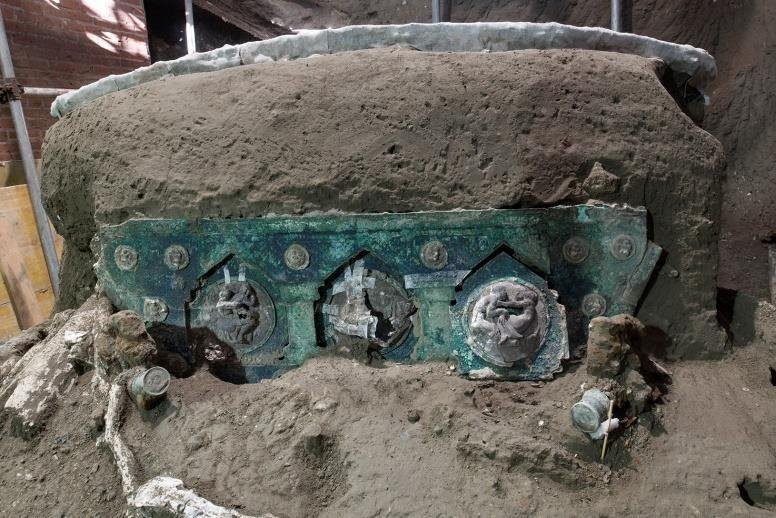Jan Bartek – AncientPages.com – A large ceremonial chariot with four wheels found in Pompeii has already been labeled an exceptional discovery that has no parallel in Italy.
What makes the chariot exceptional is that it’s almost intact despite the disaster that struck the ancient city when Mount Vesuvius erupted on August 24, 79 A.D. At the time Pompeii of the eruption was one of the largest volcanic explosions in recorded history, historical records show the population of Pompeii and Herculaneum was over 20,000. Until now, remains of over 1,500 people have been found at Pompeii and Herculaneum.

An excavation project aimed at preventing looting has led to the discovery of an almost intact Roman ceremonial chariot in Pompeii. Credit: Pompeii – Parco Archeologico
Some objects have survived this horrifying volcanic eruption, for example, a precious and striking ancient Roman painting.
Archaeologists have found remains of people buried under the ash, but it’s not often they encounter something so perfectly preserved as this ancient Roman ceremonial chariot.
Scientists unearthed the chariot while excavating the suburban villa of Civita Giuliana, beyond the walls to the north of the ancient city of Pompeii. The excavation is part of a project aimed at fighting illegal activity in the area, including tunnel digging to reach artifacts that can be sold on illicit markets.
Fortunately, looters missed the room where the chariot had lain for almost 2,000 years, tunneling by on both sides, the park’s statement said.

Atop high iron wheels, connected by an advanced mechanical system, rests the light carriage (0.90 x 1.40 m), or the main part of the chariot, where the seat was located, surrounded by metal arm and backrests, for either one or two individuals. Credit: Pompeii – Parco Archeologico
“From the very beginning, the excavation of the room where the chariot was found revealed its exceptional nature: the area in question is in fact a double-level portico which opens onto an uncovered courtyard, and which features the carbonized wooden ceiling with its network of beams, preserved in its entirety.

The carriage is richly decorated along both sides with alternating engraved bronze sheet and red and black painted wooden panels, whilst at the rear there is a complex and extensive decorative system featuring three distinct registers with a succession of bronze and tin medallions with figurative scenes. Credit: Pompeii – Parco Archeologico
“In keeping with the interdisciplinary perspective consistently adopted in the excavations of the Archaeological Park of Pompeii, archaeobotanical analyses have been carried out on the wood, which have shown that the ceiling was constructed of deciduous oak wood (Quercus sp. – cf. robur – English oak), a timber which was frequently used in the Roman age for structural elements. The carbonised wooden structure of the door on the southern side of the room, which connected the portico to the stable where the three equids were recently discovered, was also preserved, and upon analysis was identified as beechwood.

The bronze sheet is also decorated in its upper section with small medallions, also in tin, which depict cupids engaged in various activities. In the lower section of the chariot, there is a small female herm in bronze with a crown. Credit: Pompeii – Parco Archeologico

Credit: Pompeii – Parco Archeologico
The wooden ceiling was carefully consolidated, cleaned, and removed from the excavation area in order to permit the investigations to continue.
On January 7th an iron artifact, the shape of which suggested the presence of a significant buried artifact, emerged from the covering of volcanic material which had flooded into the portico, just below the removed wooden ceiling,” Archaeological Park of Pompeii reports.
This was the beginning of a startling and valuable archaeological discovery.
The ceremonial chariot was found inside a double-level portico which probably faced onto an uncovered courtyard, not far from the already-investigated stable, to which it was connected by a door.
On the chariot, researchers could clearly see iron components, beautiful bronze and tin decorations, mineralized wood remains, and imprints of organic materials.
“It is an extraordinary discovery for the advancement of our knowledge of the ancient world”, declared Mᴀssimo Osanna, outgoing Director of the Archaeological Park, “At Pompeii vehicles used for transport have been found in the past, such as that of the House of Menander, or the two chariots discovered at Villa Arianna (one of which can be admired at the new Stabian Antiquarium), but nothing like the Civita Giuliana chariot.
What we have is a ceremonial chariot, probably the Pilentum referred to by some sources, which was employed not for everyday use or for agricultural transport, but to accompany community festivities, parades, and processions.
This type of chariot, which has never before emerged from Italian soil, bears comparison with finds uncovered around fifteen years ago inside a burial mound in Thrace (in northern Greece, near the Bulgarian border). One of the Thracian chariots is particularly similar to ours, even if it lacks the extraordinary figurative decorations that accompany the Pompeian find.
See also: More Archaeology News
The scenes on the medallions which embellish the rear of the chariot refer to Eros (Satyrs and nymphs).
Considering that the ancient sources allude to the use of the Piletum by priestesses and ladies, one cannot exclude the possibility that this could have been a chariot used for rituals relating to marriage, for leading the bride to her new household.
If the entire operation had not been initiated courtesy of the synergy with the Public Prosecutor’s Office of Torre Annunziata, with which a memorandum of understanding was signed in order to combat the criminal phenomena of looting archaeological sites and trafficking finds and works of art, we would have lost extraordinary testimonies which enhance our understanding of the ancient world”.
Written by Jan Bartek – AncientPages.com Staff Writer





